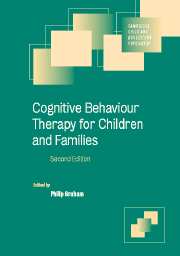Book contents
- Frontmatter
- Contents
- List of contributors
- 1 Introduction
- Part I Developmental cognitive theory and clinical practice
- Part II Engagement and assessment
- Part III Client groups
- Part IV Applications in psychosocial adversity
- Part V Applications in specific child and adolescent psychiatric disorders
- 12 Behavioural approaches to eating and sleeping problems in young children
- 13 Conduct disorders in young children
- 14 Attention deficit hyperactivity disorder
- 15 Children with developmental disabilities and their parents
- 16 Depressive disorders
- 17 Cognitive behavioural psychotherapy for obsessive compulsive disorders
- 18 Anxiety disorders
- 19 School refusal
- 20 Post-traumatic stress disorders
- 21 Disorders of eating control
- 22 Chronic fatigue syndrome
- 23 Children's interpersonal problems
- 24 Pain in childhood
- 25 Conduct disorders in adolescence
- 26 Drug and alcohol abuse
- Part VI CBT applications in preventive interventions
- Index
- References
17 - Cognitive behavioural psychotherapy for obsessive compulsive disorders
Published online by Cambridge University Press: 21 August 2009
- Frontmatter
- Contents
- List of contributors
- 1 Introduction
- Part I Developmental cognitive theory and clinical practice
- Part II Engagement and assessment
- Part III Client groups
- Part IV Applications in psychosocial adversity
- Part V Applications in specific child and adolescent psychiatric disorders
- 12 Behavioural approaches to eating and sleeping problems in young children
- 13 Conduct disorders in young children
- 14 Attention deficit hyperactivity disorder
- 15 Children with developmental disabilities and their parents
- 16 Depressive disorders
- 17 Cognitive behavioural psychotherapy for obsessive compulsive disorders
- 18 Anxiety disorders
- 19 School refusal
- 20 Post-traumatic stress disorders
- 21 Disorders of eating control
- 22 Chronic fatigue syndrome
- 23 Children's interpersonal problems
- 24 Pain in childhood
- 25 Conduct disorders in adolescence
- 26 Drug and alcohol abuse
- Part VI CBT applications in preventive interventions
- Index
- References
Summary
Introduction
At any given time, between 0.5% and 1% of children and adolescents suffer from clinically significant obsessive compulsive disorder (OCD) (Flament et al., 1988). Among adults with OCD, one-third to one-half develop the disorder during childhood or adolescence (Rasmussen and Eisen, 1990). Although some children persevere in the face of OCD, the disorder typically disrupts academic, social and vocational functioning. Hence, besides reducing morbidity associated with paediatric OCD, improvements in treating the disorder early in life have the potential to reduce adult morbidity.
Over the past 15 years, cognitive behavioral therapy (CBT) has emerged as the initial treatment of choice for OCD across the lifespan (March et al., 1997). Unlike other psychotherapies that have been applied, usually unsuccessfully, to OCD (March and Leonard, 1996), there is a logically consistent and compelling relationship between CBT, the disorder and the specified outcome (Foa and Kozak, 1991). Despite expert consensus that CBT is by far the best psychosocial treatment, clinicians routinely complain that patients will not comply with behavioural treatments and parents routinely complain that clinicians are poorly trained in CBT. Coupled with the lack of CBT-trained clinicians, the result is that many if not most children and adolescents are denied access to effective CBT. This unfortunate situation may be avoidable, given an increased understanding regarding the implementation of CBT in children and adolescents with OCD.
- Type
- Chapter
- Information
- Cognitive Behaviour Therapy for Children and Families , pp. 281 - 299Publisher: Cambridge University PressPrint publication year: 2004

